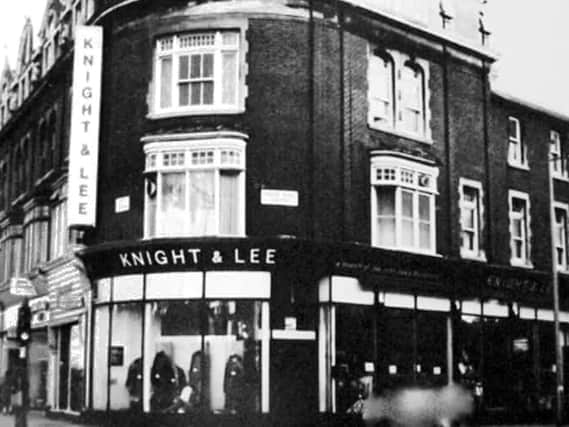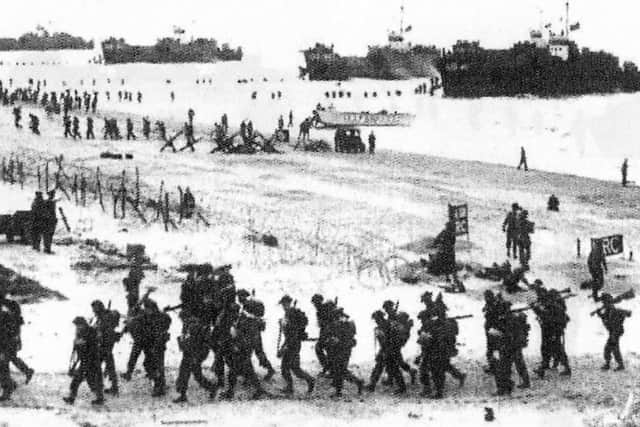Snubbing Portsmouth Dockyard for ‘posh’ clothes shop Knight & Lee – Nostalgia


He says: ‘Leaving Portsmouth Technical College aged 16, in 1951 I was destined for HM Dockyard to use my technical, woodwork and metalwork skills. But it failed to enthuse me.
‘A school visit into this gloomy, noisy, dirty environment was not helped by my friends’ unhappy tales of being ensconced.
Advertisement
Hide AdAdvertisement
Hide Ad‘Much to my father’s annoyance I commenced working in the menswear department of Knight & Lee. It was a 44 hour week (nine hours longer than today) for just £3!


‘Working in what was seen by the working classes, including me, as a 'posh area' was a revelation.
‘The clientele were demanding and staff were taught to remember names and addresses.
‘I was banished to the gloomy basement area ruled over by a Mr Sloman who had major London tailoring experience. I was ordered to listen and learn and designated as delivery boy.
Advertisement
Hide AdAdvertisement
Hide Ad‘Due to war damage, Knight & Lee’s various shops were spread across Southsea.
‘Elm Grove was hardware, Marmion Road, Grove Road was carpets, fashion was opposite St Jude’s Church and mens/boyswear was opposite Telephone House (now Chantelle Originals).
‘Our department was a happy place due to the light touch of Mr Kent, fresh from the war campaign in Italy, but we worked non-stop.
‘The general manager was a retired naval captain, not a popular choice and clueless about retailing being autocratic, aloof and elitist.
Advertisement
Hide AdAdvertisement
Hide Ad‘He screeched orders in a falsetto voice, called every one by their surnames and brooked no argument.
‘To become a Freemason would, as it was none-to-subtly told me, 'enhance my career’. But it wasn’t for me.
‘I shared my father’s view that Freemasonry was too influential in that era in obtaining both business and promotion – end of story.
‘I established a good relationship with a visiting John Lewis buyer and was told that a first-class job awaited me in the London flagship store’s buying office but that he was not allowed to poach me.
Advertisement
Hide AdAdvertisement
Hide Ad‘I had to inquire casually if there was a vacancy. I did so and made plans for my wife and I to move to London. Not so.
‘I was called to the general manager’s office and told “Don’t sit down. You are not leaving – you’re too valuable in the menswear. I do not want to hear any more about it.”
‘Fuming that my promotion had been ruthlessly destroyed I handed in my notice.
‘Summoned again, this time the deputy general manager a Mr De Vriendt who said, and I quote, “I have reason to believe if you stay, we'll offer another 10 shillings (50p) a week”.
Advertisement
Hide AdAdvertisement
Hide Ad‘I left and never regretted it. I tell this story to illustrate how much life has changed and how workers’ rights have improved and no longer can bosses map out underlings’ futures for their own selfish ends.’
I can certainly agree with Jon’s opinion of Freemasonary. I was invited to join when on the railway in London and told that I would be introduced to some very influential people.
‘Ah’ I thought, ’that’s why the railway is going down hill. People in high places through who they know rather than what they know.'
I declined the offer, as did Jon. My career went downhill from then on.
Advertisement
Hide AdAdvertisement
Hide AdMy article last Friday about Operation Fabius and the D-Day rehearsal on Hayling Island brought a memory from Alan Crockford whose father was a senior police officer.
Alan told me: 'In May, 1944 I was 13 years old. My father was the chief of police of the Havant Division, which included Hayling Island.
‘One day he told the family that he had had a visit from an army officer who told him about Operation Fabius.
‘The officer had mentioned that they were taking tanks to Hayling to make the operation more realistic.'
Advertisement
Hide AdAdvertisement
Hide AdBefore the bridge now in situ was built, bus passengers had to get off and walk across the bridge while the bus passed over and picked the passengers up the other side – and this officer thought he was going to drive some tanks over.
Alan went on: 'My father told him that Langstone bridge would collapse under the weight.
‘The officer replied that if it did they would build a Bailey Bridge in its place.
‘They did change their mind as they realised that if the bridge collapsed it would concern the residents and also the Royal Navy who were using the holiday camps on the island.’